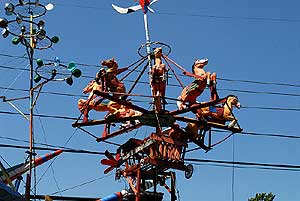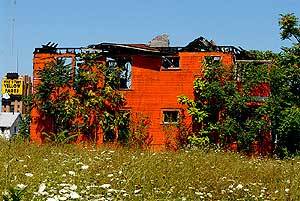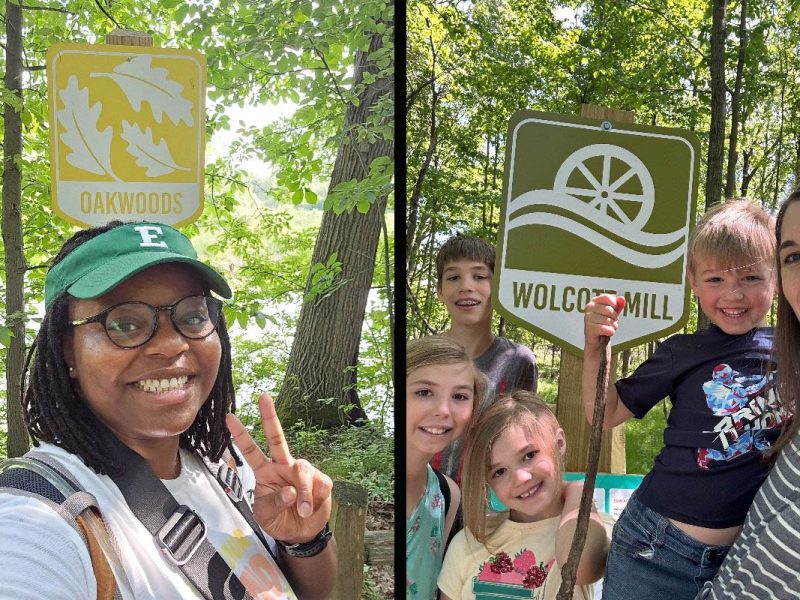Unofficial Art
A field of orange houses. Painted whirligigs and Elvises. Thousands of
Polariods. Call it what you want, but it’s all art — classic folk art
from contemporary Detroiters who need no gallery.
Dmytro Szylak is not at home. This is worth mentioning only because the
creator of Hamtramck Disneyland, a homemade construction that has been
growing vertically on two adjacent garages since 1990, has nearly
always been present to greet tourists from Japan, England, Germany,
Canada, New York, California and students from a multitude of art
colleges when they come calling day or night.
 A Ukrainian
A Ukrainian
immigrant who worked in a General Motors factory for 32 years before
retiring two decades ago, Szylak is one of the more gracious outsiders
among the seemingly growing number of Detroit outsider artists who have
converted their private homes and businesses — and in some cases, their
entire lives — into very public displays. Now in his mid-80s, Szylak
has been known to invite visitors into his kitchen for a snort of
fruit-flavored vodka or brandy, or play Ukrainian folk music that he
says goes best with viewing the Concorde jet he made as part of the
Disneyland project. His still-expanding art work sprawls across the
garage directly in back of Szylak’s home on Klinger near Carpenter on
Hamtramck’s north side, and connects to the one next door that he also
owns. The massive piece includes spinning bicycle wheels, found
paintings of Elvis and other pop culture icons, Christmas lights that
remain year-round, wooden soldiers armed with toy guns, American flags
and other objects that flap, turn in the breeze and delight nearly
everyone who sees them. Though not everyone was always delighted. When
Szylak first began developing Disneyland 16 years ago, his neighbors
and some city officials were aghast. But he killed his critics with
kindness, and briefly became a celebrity when Hamtramck’s then-Mayor
Gary Zych — who has an MFA in sculpture from Cranbrook’s Academy of
Fine Arts — and Zych’s mentor, the critic, sculptor and folk art
collector Michael Hall began
including pieces of Szylak’s whirligigs in local art shows and singing
his praises on the lecture circuit. Thanks to political and
art-academic muscle, Disneyland gained status as a national must-see,
alongside the more established Watts Towers in Los Angeles and Howard
Finster’s
Paradise Garden in rural Georgia. Szylak’s construction has since been
featured in several television shows and magazines around the world,
including England’s Raw Vision.
 Earlier this summer, Disneyland received an unlikely visit from
Earlier this summer, Disneyland received an unlikely visit from
the world’s most notorious woman of the moment, supermodel Kate Moss,
and famed New York fashion photographer Bruce Weber. The
pair was in Detroit doing a shoot for an upcoming spread in W magazine.
The Moss shoot also included the
long-abandoned Michigan Central Train Station and other Detroit-area
backgrounds, places coveted by photographers for their high content of
gritty, timeless Americana.
Orange houses and trees of heaven
 On
On
a recent morning, when the air was not yet hot and skies were clear
with a rich blue color, Model D photographer Dave Krieger and I set out
to find a few more Detroit folk art treasures lesser known than
Szylak’s work-in-progress. Leaving Hamtramck, we drove west to Highland
Park, where a series of abandoned houses along Davison near the John
Lodge Freeway have been painted bright orange. This is the unofficial
work of some anonymous Cranbrook art students, says Rebecca Mazzei, the
arts editor at Detroit Alternative Weekly the Metro Times.
“This
comes from an entirely different aesthetic than the outsider
tradition,” Mazzei says. “These artists are trying to force the city’s
hand in demolishing abandoned homes, and it seems to have worked in
some cases.” In a story Mazzei wrote in March, she called the effects on the structures “astonishingly
beautiful.”
On a block behind the orange houses north of
Davison at Trumbull, tucked away in a corner of Highland Park where the
landscape is overrun by the Ailanthus altissima, otherwise known as the
ghetto palm and even more poetically called the tree-of-heaven, we
dodged concrete blocks placed on the street to prevent motor access in
this neighborhood, and rolled through an empty field where the grass
was so high it could be grasped through the passenger side window of
Krieger’s truck.
 Then, as if we entered another dimension
Then, as if we entered another dimension
entirely, we found ourselves on the meticulously well-groomed Grand St.
heading toward Hamilton Ave. The street included one Craftsman-style
house that was neatly landscaped and had ornamental objects strewn
about its front porch. We knocked on the door but no one was home. Some
men on the street told us everyone on the block took pride in keeping
up the neighborhood. One of the men, Kevin Jackson, said his uncle
Leroy Jackson, owns the interesting house.
“He’s been working on
it for a long time,” says Jackson, who’s 47 and was living on the block
when he attended Highland Park Community Schools in the 1970s. “My
uncle wants to keep up the neighborhood, just like all of us do.
There’s no drugs on this block, just people doing their best to live a
decent life.”
The land of 10,000 Polaroids  In
In
an old Southwest Detroit neighborhood, at the intersection of Lawndale
and Chamberlain streets, is a place you would never know existed …
unless you know, of course. At the Lawndale Market, where the
inscription “God loves you” stands out more boldly on the façade than
the actual name of the business, you will find a refrigerated case
stacked with fresh submarine sandwiches, aisles of canned and packaged
foods, beer, wine and liquor, and a lottery machine. On the wall above
the shelves of liquor, and on opposite walls that frame the interior of
the store, are portraits and posters of Marilyn Monroe. Asked to
explain why, his best answer is the most obvious: “I like her,” owner
Amad Samaan says.
Most unexpectedly, however, about 10,000
Polaroid snapshots hang from the ceiling. The hanging pictures are of
customers who have come into Samaan’s store since he inherited it from
his father in the 1990s. Before that, Samaan worked in a Chrysler
factory, he says, “for money.” This, he says, “I do for love.”
 At
At
first, he was reluctant to talk about his photo project and says he’s
chased reporters “from CNN and everywhere else” from the store because
“I don’t need no one to know about me.” But soon he warms up to the
idea of a story and takes turns posing for pictures with us. He points
up to photos of pregnant women, men in Halloween costumes and children
staring into the camera lens. There is no pretense of professionalism.
Like family photos long ago hidden away in shoeboxes, the images are
smudgy, yellowing in the humid air. But they possess the intimacy of
real life, of people making simple contact with one another, an essence
that appears to have become most rare.
“Write about them in
the pictures,” Samaan says. His shirt has the top three buttons open,
gold chains cross his tanned neck. He lights a cigarette. “Write about
God’s love. I’m not the important guy.”
Walter Wasacz is a freelance writer and DJ. This is the first in his
series of stories on Detroit’s originals, the people and places that
make an impact on cultural life in the city.
Photos:
Hamtramck Disneyland
Orange Ruins in Highland Park near Hamilton and Davison
Lawndale Market
Amad Samaan
All Photographs Copyright Dave Krieger





